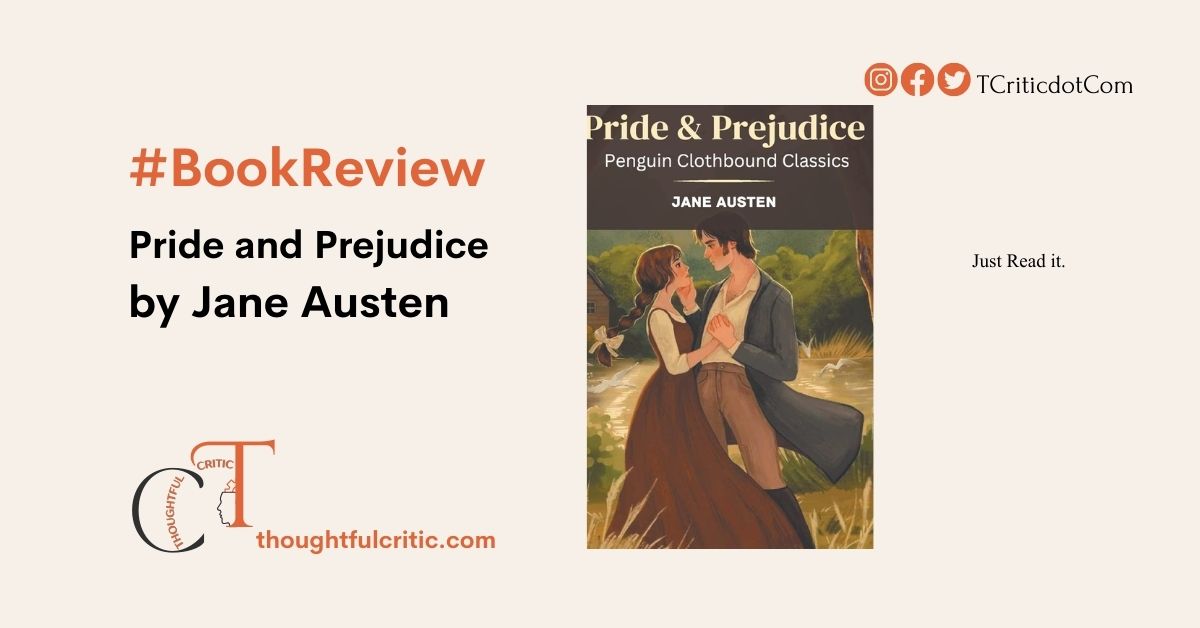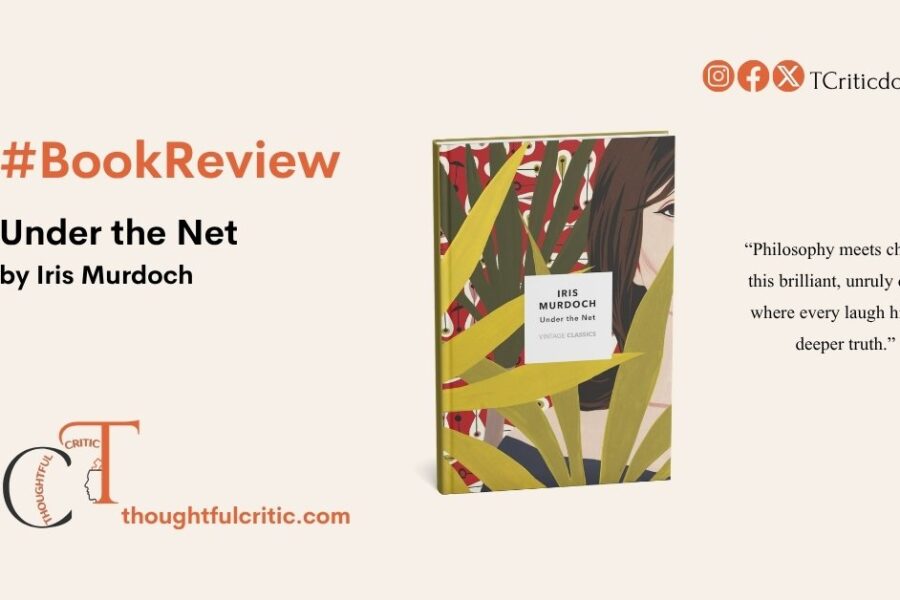Who doesn’t love old wine? Well, there are many, in fact! I haven’t tasted even a drop of this aesthetic marvel that transports a person to a different realm. However, when it comes to old books, there may be very few who might run away. Like old wine, old classics also have the prowess to transport a person to a different world. Now that we are discussing old books and classics of literature, who doesn’t love Jane Austen? The beloved lady novelist with many a talent to tell the stories of love with freshness and newness every time! Thoughtful Critic has tasked me to review Austen’s works. And let us begin with the worldwide bestselling one – Pride and Prejudice!

Title: Pride and Prejudice
Author: Jane Austen
Publication Date: 1813
Publisher: T. Egerton, Whitehall (first edition)
Genre: Novel, Romance, Social Commentary
Language: English
Pages: Approximately 432 pages (first edition)
Buy the Book: Click here to buy from Amazon (Penguin Special Clothbound Edition)
Overview
Pride and Prejudice, authored by Jane Austen and published in 1813, is one of the most beloved novels in English literature. The story, set in the early 19th century, follows Elizabeth Bennet, a sharp-witted young woman navigating the complex social landscape of rural England. Austen’s novel is a tale of love and marriage and a keen critique of societal norms, class distinctions, and the delicate balance of propriety and passion. This review delves into the intricate layers of Pride and Prejudice, examining its narrative style, thematic depth, character development, and enduring literary significance.
The Story in Brief
At the heart of Pride and Prejudice is Elizabeth Bennet, the second of five sisters living with her family in the English countryside. The novel begins with the arrival of Mr Charles Bingley, a wealthy bachelor, in the neighbourhood, stirring excitement and speculation among the Bennet family. Bingley quickly attaches to Elizabeth’s elder sister, Jane, while Elizabeth is drawn to Mr. Darcy, Bingley’s reserved and seemingly arrogant friend. The novel follows Elizabeth and Darcy’s tumultuous relationship, marked by misunderstandings, social expectations, and personal growth. Through a series of events—including Darcy’s pivotal letter, revealing the truth behind his actions—Elizabeth and Darcy overcome their initial prejudices and pride, leading to one of literature’s most celebrated unions.
Narrative Style
Austen’s narrative style in Pride and Prejudice is both elegant and accessible. Written in the third person, the novel often focuses on Elizabeth’s perspective, allowing readers to engage closely with her thoughts and emotions. Austen’s use of free indirect discourse, a technique that blends third-person narration with first-person thoughts, brings readers into Elizabeth’s inner world without breaking the narrative flow. This style is particularly effective in portraying Elizabeth’s wit, her evolving feelings towards Darcy, and her reflections on the societal pressures she faces. Its clarity and irony mark Austen’s prose and sharp social commentary, making the novel as enjoyable today as it was over two centuries ago.
Themes
- Social Class and Marriage: Pride and Prejudice is deeply concerned with the social structures of Regency England, particularly the institution of marriage. Austen critiques the mercenary nature of marriage arrangements, as seen in characters like Charlotte Lucas, who marries the obsequious Mr. Collins out of practicality rather than love. The novel explores how class influences relationships and personal happiness, ultimately advocating for marriages based on mutual respect and affection.
- Pride and Prejudice: As the title suggests, the themes of pride and prejudice are central to the novel. Her prejudice against his apparent arrogance clouds Elizabeth’s initial judgment of Darcy, while Darcy’s pride leads him to dismiss those he deems socially inferior. The novel charts their journey towards self-awareness and humility, highlighting the dangers of allowing these flaws to cloud one’s judgment.
- Family and Reputation: The Bennet family dynamic plays a significant role in the novel, with each member’s behaviour affecting the family’s social standing. Mrs. Bennet’s embarrassing pursuit of suitors for her daughters, Lydia’s reckless elopement, and Mr. Bennet’s neglect of his parental duties all serve as critiques of family responsibility and the impact of individual actions on collective reputation.
- Individuality vs. Social Expectations: Elizabeth Bennet stands out as a character who values her convictions over societal expectations. Her refusal of Mr Collins’s proposal, despite its security, and her initial rejection of Darcy’s first proposal reflect her desire for authenticity in her relationships. Austen celebrates Elizabeth’s independence, even as she navigates the constraints of her society.
Character Development
Elizabeth Bennet: Elizabeth is the novel’s heroine, known for her intelligence, wit, and strong moral compass. Throughout the story, she learns to balance her independent spirit with the realities of her world, leading to her eventual understanding and acceptance of Darcy. Elizabeth’s character development is central to the novel’s exploration of pride, prejudice, and the complexities of human relationships.
Fitzwilliam Darcy: Initially introduced as aloof and arrogant, Mr. Darcy’s character gradually unfolds to reveal a man of deep integrity and sensitivity. His transformation, driven by his love for Elizabeth and her candid rejection of his initial proposal, underscores the novel’s theme of personal growth. Darcy’s character arc is one of the most compelling in literature, as he moves from a figure of disdain to one of profound respect and admiration.
Supporting Characters: The novel has a rich cast of supporting characters, each contributing to its themes and narrative. Jane Bennet’s kindness contrasts with Elizabeth’s sharpness, Mr. Bennet’s cynicism reflects the pitfalls of disengagement, and Lydia’s recklessness highlights the dangers of unchecked youthful exuberance. Characters like Lady Catherine de Bourgh and Mr. Collins offer a satirical look at the absurdities of class and social ambition.
Literary Significance
Pride and Prejudice is a cornerstone of English literature, celebrated for its incisive social commentary and masterful depiction of character. Austen’s exploration of the complexities of love, marriage, and society remains relevant today as readers continue to find resonance in Elizabeth’s journey towards self-discovery and fulfilment. The novel’s enduring popularity speaks to Austen’s genius in capturing the universal experiences of human nature with wit, humour, and empathy.
Critical Analysis
Pride and Prejudice has been the subject of countless analyses, with critics praising Austen’s sharp social observations and ability to craft fully realized characters. While some have critiqued the novel’s focus on marriage as limiting, others argue that Austen uses the institution as a lens to explore broader societal issues. The story explores themes such as class, reputation, and individual agency, ensuring its continued relevance in literary discourse.
Austen’s handling of the narrative, particularly her use of irony and free indirect discourse, is often highlighted as one of her greatest strengths. This technique allows readers to experience the characters’ thoughts and emotions intimately, making the story’s twists and turns all the more engaging. Austen’s subtle critiques of her characters, often delivered with a light, satirical touch, add depth and complexity to the narrative, inviting readers to consider their judgments and preconceptions.
Appreciation for the Author
Jane Austen’s Pride and Prejudice is a testament to her extraordinary talent for storytelling and social critique. Austen’s ability to weave together humour, romance, and keen observations of human behaviour has earned her among the greatest novelists ever. Her characters are not merely products of their time but resonate with readers across generations, reflecting universal truths about love, society, and personal growth. Austen’s deft use of irony, her masterful dialogue, and her nuanced portrayal of relationships make Pride and Prejudice a novel that continues to captivate and inspire readers worldwide.
Conclusion
In conclusion, Pride and Prejudice by Jane Austen is far more than a simple love story. It is a rich exploration of societal expectations, individual agency, and the complexities of human relationships. Austen’s sharp wit, unforgettable characters, and insightful social commentary make this novel a timeless classic. Whether reading it for the first time or revisiting it years later, Pride and Prejudice offers something new with each read, affirming its place as one of the most cherished works in the literary canon.
Review of other Novels by Austen:
By Vyom for Thoughtful Critic





Can I ask who wrote this review? It’s for a paper.
Please find the name: Vyom Jha.
Thanks!